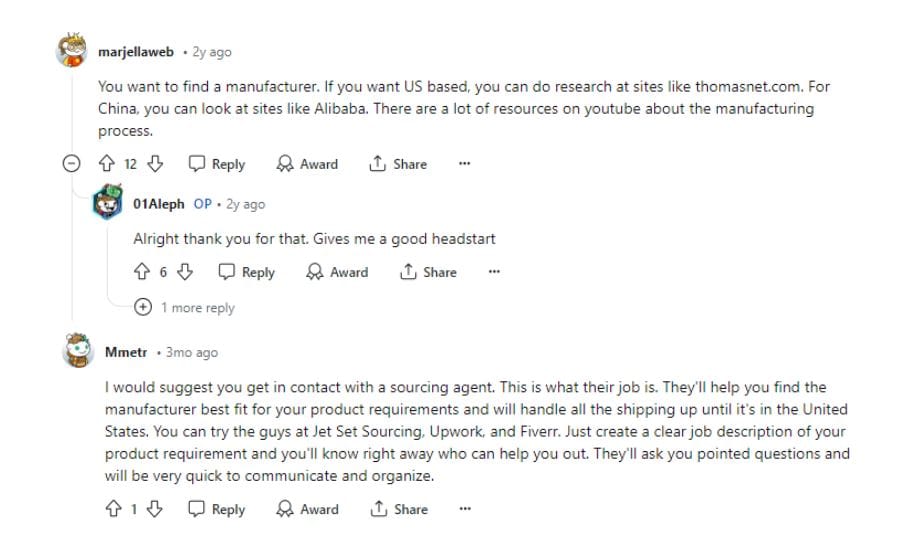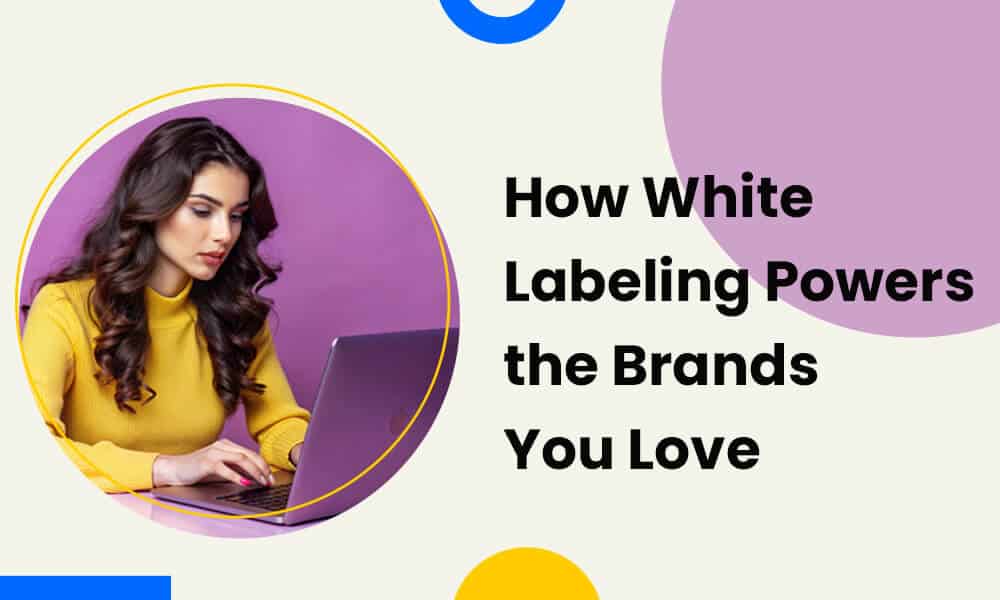Love that graphic T-shirt at Target or those fashionable sunglasses from Vogue?
What if we tell you they’re not as unique as you think they are? Chances are the brand does not even produce them. A white label business called Luxottica makes sunglasses for Vogue and all the big brands like Prada, Chanel, Versace, and many others you can think of.
White labeling is becoming an increasingly popular work model for those businesses that want to launch a new product or service quickly without any upfront costs. You don’t have to be Dior to be a white label reseller. It can be a lucrative option for new and growing businesses, too.
This guide provides all the information you’ll need to understand white labeling. Stay with us until the end to learn everything, from what a white label product is to how to get started selling it.
Table of Contents
White Labeling – What It Is
White labeling is a business model in which a business uses a product or service from a third-party provider. The business then relabels it to sell under its own branding. This allows a business to showcase and sell products as its own without producing them.
Several known businesses use white label products or services. Store brands for big box retailers, such as 365 by Whole Foods or Great Value by Walmart, purchase white label products bought from a third-party manufacturer and sell them with their branding.
White label products can also be services. Have you ever checked a frequent flyer card for an airline, say Delta? Well, you’ll see American Express written on it somewhere. Macy’s credit card is also from American Express.
So, if you see any non-financial institution without banking operations offering branded credit cards, it uses white label credit card services.
You can white label services for various other things, too, such as web hosting, digital marketing, reputation management, and so much more. We’ll discuss that later in this article, but before we get to that, let’s point out what isn’t white labeling.
So, in short, white label refers to a product or service produced by one company and sold by another.
White Labeling – What It Isn’t
People often get confused between white label products and private label products. However, understanding the distinction between the two is foundational to choosing the right business model.
A white label solution is generic or non-branded. A third-party producer sells them to a business, which may sell them under its brand name.
Private-label products, on the other hand, are company-specific. They’re produced by a third-party provider but sold exclusively by a single company.
For example, a print-on-demand business, such as Printify, Printful, Qikink, etc., allows users to customize white label merchandise and sell it independently. Therefore, various merchants can sell the same t-shirts from these POD platforms in unique designs.
On the other hand, Zara is a private label company that may source items from a third-party producer, but they’re exclusively designed and sold by the company.
Some Industries Utilizing White Labeling
White labeling is quite a popular choice for businesses these days. Big retailers like Walmart, Costco, and Amazon heavily rely on generic products sold under their own brand names.

Let’s look at some key industries around the world that use white label or generic products and services.
Grocery and retail
As we mentioned earlier, the grocery and retail market is big on white labeling, with some big names selling white label products as their own branded products.
With white labeled items, retailers like Costco and Target can offer quality goods, be it day-to-day groceries, cleaning supplies, or household products, at a cheaper price with their own branding.
Software
Many software companies offer white label services, too. Say your small content marketing agency can offer email marketing with white label software from EngageBay or Mailchimp.
Payment processing
We mentioned how American Express offers white label financial services with credit cards and a loyalty program. But did you know you can even get a white labeled payment processing solution for your business?
Businesses like Stripe offer a white label payment experience that is fully embedded with your online business. Platforms like Shopify and Lightspeed are already using it.
Beauty and personal care
White labeling is quite common in beauty and personal care. Famous cosmetic and skincare brand Kylie Cosmetics outsource product manufacturing to white label manufacturers like Seed Beauty. These brands then package the white-label products under their own brand names.
Fashion and apparel
A fashion brand doen’t need to be involved in the design or manufacturing process to provide a wide selection of apparel and accessories. Take the real world example of Afro Unicorn, a cute children’s apparel and accessories brand.
It sources the products from a print-on-demand business that prints unique designs on white labeled clothes.
Why Are Businesses Leaning Towards White Labeling?
So, now you know that white labels are the name game with various industries, but why? Isn’t in-house production cheaper?

When your business has specific core competencies, starting new in-house units for offering different solutions demands quite a lot of resources. These resources could be time, energy, and money needed to prepare and run a production house from scratch.
And let’s not forget the legalities of licensing and other compliance requirements.
White labeling allows you to skip all these and step right into the market with your new product, focusing on rebranding and marketing. When you do the latter right, you maximize the opportunity to expand your revenue and diversify your revenue streams.
All the money you make doesn’t need to go into production or development again but right into your core competencies and gain a competitive edge.
Businesses choose white labeling to avoid costs like the following:
- New brand and company incorporation
- Raw materials and equipment
- New expertise recruitment
- New customer service department
- R& D department
- New product development
- Product licensing
- New packaging design and development
- Brand image and reputation development
Businesses choose white labeling to access assets like the following:
- Brand, company, and its customers
- The sales teams
- Customer service
- Marketing and promotion resources
- Brand and reputation advantage for marketing
- Designs, logos, and other white label branding elements
White label companies mass-produce these products and services to offer them at competitive prices without compromising quality.
So, even you can offer the product or service to the end user at a lower cost than other brands — a win for everyone in the ecosystem!
When Is White Labeling a Good Idea?
White labeling is often a good option for businesses that don’t want to:
- Invest in the extensive development and production
- Wait too long to enter the new market with a product
Question: Is white label solution a good idea for you?
Answer: It might be if you’re considering a new product trend or simply want to capitalize on your market position.
After asking magnates around the world, we realized businesses often lean towards white label services or products when they want to:
- Introduce something new that complements their existing product or services
- Drive revenue or performance by doing something different
- Cater to a customer base that’s outgrown internally produced products
- Scale with a predictable cost structure
- Seize an opportunity that you don’t have resources for but don’t want to deny
White label companies enable businesses to grab new opportunities and possibilities. You may confidently plan for any company expansion, knowing you have the resources to pursue even the most demanding and substantial clients.
Read also: How To Maximize Profits With Private-Label Products (2024)
The White Label Business Model You Should Know About
If you’re considering white labeling, you will need to understand how it works to know who plays a role in the success of these new products. The journey of a white label solution from its inception to its sale is as follows.
The origin
It all begins with a dedicated manufacturer or service provider specializing in producing high-quality products or delivering top-notch services. They offer white labeled services and products in bulk volumes that are unbranded and offered at a lower cost.
Rebranding
Enter the retailer (this can be you) with a vision. They recognize the potential in these unbranded products or services. Then, the company purchases these products or services from the white labeling business and simply repackages them with its unique branding.
Reach
After the rebranding, the products or services go into the hands of your marketing team for the crucial task of distribution and marketing. Your marketing department ensures the products or services reach the target audience through well-established channels and strategic marketing campaigns.
Connection
Now, these rebranded products or services reach customers. They can be distributed through various online marketplaces, such as Amazon, in addition to your website, or you can leverage physical distribution channels, such as retail stores or supermarkets.
Combining both for maximum touchpoints makes it easier for customers to find these products.
Satisfaction: with the customer
Finally, the journey culminates in the hands of the end customers. They receive the rebranded products or services, delighted with the quality and the brand they trust – your company!
You get customer satisfaction from the value and reliability of the offerings, unaware of the intricate production processes that brought them these offerings.

Steps to Start Your Own White Label Reseller Program
Starting white label reselling requires thorough research into what you want to sell, whom you’ll sell to, and how you’ll supply it.
Research and identify the product or service
The first step to starting any new business is determining what you’ll sell and whether it’s even in demand. Look for gaps within your market and analyze the needs of your existing target audience. Ideally, the new product should align with your current offer and fit your brand’s values well.
So, for example, if you’re selling vegan products, launching new leather wallets is an obviously unfit decision. But new product lines of faux leather and organic cotton wallets that look better than real leather wallets.
Here are some emerging products or services in different industries that you can consider white labeling.
| Industry | Emerging Product or Service |
| Digital marketing | TikTok advertising, OTT advertising, social content, Spotify advertising, paid social and PPC advertising, search engine optimization (SEO) services, programmatic display advertising, and YouTube advertising. |
| Dropshipping | Reusable stainless steel water bottles, health foods, customized fitness apparel, organic beauty products, aromatherapy diffusers, personalized jewelry, yoga mats, home decor, pet accessories, educational toys, custom-printed books and journals, board games, and puzzles. |
| Fashion | Custom t-shirts, hoodies, footwear, athletic wear, cartoon-themed t-shirts, and sustainable fashion items like reusable tote bags made from recycled material. |
| Electronics | AI gadgets and smart devices, wearable technology like smart rings and watches, organic electronics, advanced material electronics like gallium nitride (GaN) semiconductors for electronic vehicles, smart home devices, consumer electronics, and IoT technology. |
| Skincare | Personalized and made-to-order skincare, skincare gadgets like LED masks and microcurrent devices, natural and organic cosmetics, lymphatic drainage tools like gua sha and rollers, and face masks. |
| Accounting | AI-powered SaaS tools for data entry, payroll processing, and financial forecasting, blockchain-enabled solutions, predictive analytics and reporting tools, cloud-based accounting software, virtual collaboration platforms, cybersecurity solutions, sustainability, and ESG reporting tools. |
| Pet accessories | GPS dog fences, lick mats, GPS and AI-powered health trackers, AirTag collars, car beds, air purifiers, eco-friendly pet products, fashion-forward accessories, pet cooling scarves and wearables, and enrichment toys. |
| Website hosting | Website builders, cloud hosting solutions, AI-generated design tools, landing page builders, SEO and analytics tools, e-commerce development, email marketing platforms, social media management tools, and CRM tools. |
Pro tip: Who better to tell you what customers would love to buy from you than your existing customers? Send out survey forms to your customers and let the audience speak for themselves.
Here’s an example of a customer survey email (designed by EngageBay):

Find a manufacturer or service provider
Once you’ve decided on what product or service to launch under your brand name, find a reliable white label company. As you look for white label partners, don’t just decide based on costs. Prioritize their expertise and quality, too!
You’ll also have to decide whether you want to work with national brands or international ones. Both have their own pros and cons.
| Domestic | International | |
| Pros |
|
|
| Cons |
|
|
No matter which one of the white label providers you choose, you need to be able to trust them. But before you figure that out, you need to find them and shortlist them. How do you do that?
- Check online directories, such as Alibaba, Wonnda, ThomasNet, etc.
- Attend trade shows and industry expos to meet domestic and international manufacturers in person
- Ask users of Quora or Reddit for referrals
Check what users on Reddit have to say about finding white label companies:

Once you make a list of potential suppliers, reach out directly to negotiate terms. You can use LinkedIn, a great networking platform for new business. To make this easy, we’ve given a template below for a personalized connection message.
Connect with white label manufacturers message template
Subject: Collaboration opportunity with [your company name]
Message:
Hi [Manufacturer’s Name],
My name is ____ from [Your Company Name]. We are exploring opportunities to expand our product/service line and want to explore a possible collaboration with [Manufacturer’s Company Name].
Your expertise with [Specific Product or Service] has caught our attention, and I believe there is a potential for a mutually beneficial partnership.
Could we connect to discuss this further?
Cheers!
[Your signature]
Pro tip: Check out the White Label World Expo, where online merchants and sellers, new companies, and entrepreneurs looking to grow their enterprises may find everything they need, from product sourcing to online sales.
This expo is a great opportunity for thousands of professionals to network with manufacturers and suppliers of white label and private label items!
Evaluate and test the product
Now it’s time to TEST, TEST, and TEST!

There are so many criteria your new product or service should stand up to before you decide to launch it in the market. After all, you don’t want to invest all that money just to find out your customers won’t continue buying it.
Pro Tip: Conduct a small focus group or beta test with a segment of your target audience. Their feedback can provide valuable insights into product improvements and market readiness.
Criteria for testing your new product or service
| Criteria | Questions to Ask |
| Quality and usability |
|
| Differentiation |
|
| Scalability |
|
| Cost efficiency |
|
| Sustainability |
|
Negotiate terms
Striking a balance between expressing your interests and discovering solutions that benefit both parties is essential in a negotiation. Strive for win-win outcomes in which everyone benefits. Prioritize the non-negotiable features important to your brand’s success while being flexible and ready to compromise on other parts.
Focus on value with your contract. Yes, cost is an important negotiation term, but it’s not everything. You want provisions for quality control and after-sales support, too.
Investing in high-quality products and services can lead to a better reputation for your business and happier customers. And this, my friends, pays dividends in the long run!
Remember: This step is important because it will ensure the contract does not contain ambiguity that could lead to disputes later. Keep a legal advisor as a middleman in drafting a fair and legally binding contract.
What to include in your contract?
Negotiate and include the following terms of your agreement in your contract:
- Minimum order quantity (MOQ)
- Prices
- Production and delivery schedules
- Quality standards
- IP rights
- Payment terms
- Scope of customization
- Dispute resolution mechanisms
Customize the brand
Now, you’ve got a white label partner for production or providing service. It’s time to brand white label services or products and make them yours!
If you’ve got an already established business, this step is easy peasy.
Get your designers to package the white label product or service in the same way other products or services are packaged. You can recycle the standard logo, labels, usage instructions, etc. Just stick to the brand guidelines.
Branding tips for new businesses
- Define your brand identity: Determine what your brand stands for and wishes to achieve. This will guide all branding efforts.
- Understand your target audience: Learn their preferences, needs, and expectations, and tailor your white label branding to appeal to them.
- Strive for a memorable brand: Choose a name and logo design that reflects your brand identity. Your brand name should be easy to pronounce, and the logo should be simple, as these things stick with the human brain longer.
- Develop brand guidelines: Define your visual identity with brand colors, typography, and imagery style. Also, define the tone of voice for all communications. Do you want it to be friendly, professional, or playful?
- Customize packaging and labeling: Design your packaging and labeling according to the branding guide. It should be visually aesthetic and functional.
- Ask target audience: Seek customer feedback on your brand elements with surveys. Use this information to refine your brand identifiers and keep your brand relevant.
Pro tip: White label branding doesn’t just mean slapping your logo on a product or service. It should also fit in your brand story. Master brand storytelling in engaging content around the new product or service in blog posts, social media updates, videos, and more.
Develop a marketing and sales strategy
One obvious disadvantage of white labeling is that the generic product or service isn’t unique to one company. Anyone can get the identical products from the same manufacturer or service provider. So, you MUST hyperfocus on differentiating your brand with your marketing efforts.
How will you do that? With a unique position and messaging strategy.
Highlight your USP, not just the product but also your brand. You’ve already got a loyal customer brand; remind them why they should buy this product/service from you, too.
You can also attract new customers with targeted digital marketing strategies.
- Optimize landing pages for the new product or service for search intent
- Take it to your social media channels to show off your new product or service
- Run targeted PPC and social media ads
- Use email marketing campaigns to nurture leads, share updates, and promote your products
Pro tip: Get influencers onboard to extend your reach. You can also incentivize and promote user-generated content over all platforms to build credibility and trust quickly.
A/B testing for marketing campaigns
A/B testing, or split testing, lets you compare two versions of a marketing element of your campaign. The goal is to identify which version will provide better results based on a defined metric, such as click-through rate, conversion rate, or engagement.
- Choose any one element to test – email headlines, CTA, images used in the campaign, landing page layout, etc.
- Create two variations of the element
- Test on two groups of your audience for a defined period of time
- Compare the results to conclude which one performed better
- Once you’ve got a winner, roll out the changes for the entire campaign for everyone
By systematically applying A/B testing to your broader marketing efforts, you can make data-driven decisions for better performance and results.
Launch the product
Finally, we’re at the last step …

It’s time to use your preexisting sales channels to offer the new product or service to the target audience. While you may think it’s the end, it’s only the beginning (sorry!)
Implement a soft launch and check how the customer responds. It can offer some good feedback on where to improve.
Once you feel the new product or service is performing well, launch it full-scale with targeted marketing campaigns to maximize its impact and reach.
Pro tip: Collect customer testimonials after a soft launch. Build case studies and use them during a full-scale launch to develop credibility and generate buzz around your product or service launch.
Use EngageBay’s free customer survey email templates to collect feedback for your new product or service.
How a College Student Spent $300 on a Side Business to Generate More than $500,000 in Revenue!
White labeling doesn’t require a big budget or a specific age to get started, and nothing demonstrates this better than Siu, a University of Hawaii at Manoa student. Siu invested $300 to start a side hustle selling LED car stickers. He called his company Invalid.jp.
In October ‘21, Siu’s product was featured in a viral TikTok video. That day, he sold stickers worth $12,000. Next year, another video went viral with over 9 million views, making $38,000 worth of sales within 23 hours.
By 2022, the company brought in a total revenue of $512,000. That’s 1,700x his investment!

Now, you’ve got so many vendors for car stickers. You can find some cool designs on Amazon, Alibaba, and other such marketplaces. You can order some yourself and start selling them under your brand name. But will you succeed as Siu did?
The answer isn’t Siu’s sheer luck or some special talent. It’s simply about marketing the products well! Invalid.jp took off because of increased brand exposure to a wide audience on TikTok. So, if you put a little effort into marketing your business, you can do it, too!
Besides more conventional forms of advertising like Facebook, short video marketing platforms like TikTok and Instagram do well for unique items that target younger audiences. Email marketing also offers a great way to build a loyal customer base and promote your new white label product or service.
Conclusion
Siu’s story illustrates that no matter your age, budget, or business size, you can start a white label reseller business and make it big. With high-quality products and services from established white label brands, you can enter a new market quickly with minimal upfront costs.
Study your audience, build your marketing plan, and work on reaching your audience on the right platforms. A customer relationship management (CRM) system can be a great tool for better understanding your audience, streamlining marketing campaigns, and enhancing customer engagement.
With EngageBay’s comprehensive sales, marketing, and support solution, you can take your marketing efforts to the next level. Sign up today to get started!
FAQ
1. How do I choose the right white label products for my business?
To choose the right white label products, follow the steps below:
- Start by researching market demand and identifying gaps within your niche
- Align the new product with your existing offerings and brand values
- Conduct surveys or focus groups with your current customers to get their input on potential new products
- Ensure the product meets high-quality standards and differentiates itself from competitors
- Evaluate the scalability and cost efficiency of the product
2. What are the most profitable white label products in 2024?
Some of the most profitable white label products in 2024 include:
- Reusable stainless steel water bottles
- Health foods
- customized fitness apparel
- Organic beauty products
- Aromatherapy diffusers
- Personalized jewelry
- Yoga mats
- Home decor
- Pet accessories
- Educational toys
- Custom-printed books and journals
- Board games and puzzles
3. How do I find reliable white label providers?
You can find and shortlist white label providers through:
- Online directories: Use platforms like Alibaba, Wonnda, and ThomasNet.
- Trade shows and industry expos: Attend events to meet manufacturers and suppliers in person.
- Online communities: Seek referrals from users on Quora or Reddit.
- Direct outreach: Use LinkedIn to connect with potential suppliers and negotiate terms.
Remember, when selecting a provider, prioritize quality and expertise over cost.
4. What is the difference between white labeling and private labeling?
White labeling involves selling a generic product or service a third party produces under your brand name. Anyone can get the same product or service from the white label company and rebrand it. However, private labeling is company-specific.
A third-party provider may produce products, but they are exclusively made for the private label company.
5. What are the legal considerations for white labeling?
When engaging in white label selling, consider the following legal aspects:
- Contracts: Ensure clear terms on minimum order quantities, prices, production schedules, quality standards, IP rights, payment terms, and dispute resolution.
- Licensing and compliance: Adhere to local regulations and licensing requirements for the products you are selling.
- Intellectual property: Protect your brand and designs with proper IP agreements.
- Quality control: Include provisions for quality assurance to avoid legal disputes related to product quality.
6. How can I effectively market white label products?
To effectively market white label products:
- Targeting the right audience: Create ideal customer profiles to find and target the best customers with your marketing efforts.
- Digital marketing: Target above-mentioned audience with PPC and social media ads, email marketing campaigns, and landing page optimization for search intent.
- Highlighting USP: Emphasize what sets your product and brand apart from competitors in all the marketing content.
- Influencer and user-generated content marketing: Collaborate with influencers and promote user-generated content to build trust and credibility.
7. What are the common challenges in white labeling, and how can they be addressed?
You can successfully navigate the white labeling landscape by addressing the following challenges proactively and building a profitable business:
- Quality control: Ensure the product meets your standards through rigorous testing and assurance measures.
- Brand differentiation: Stand out in the market with unique branding and marketing strategies.
- Supply chain management: Maintain reliable supply chains to avoid stockouts and delays.
- Legal compliance: Adhere to all relevant regulations and licensing requirements.
- Customer perception: Build a positive brand image through consistent quality and excellent customer service.
